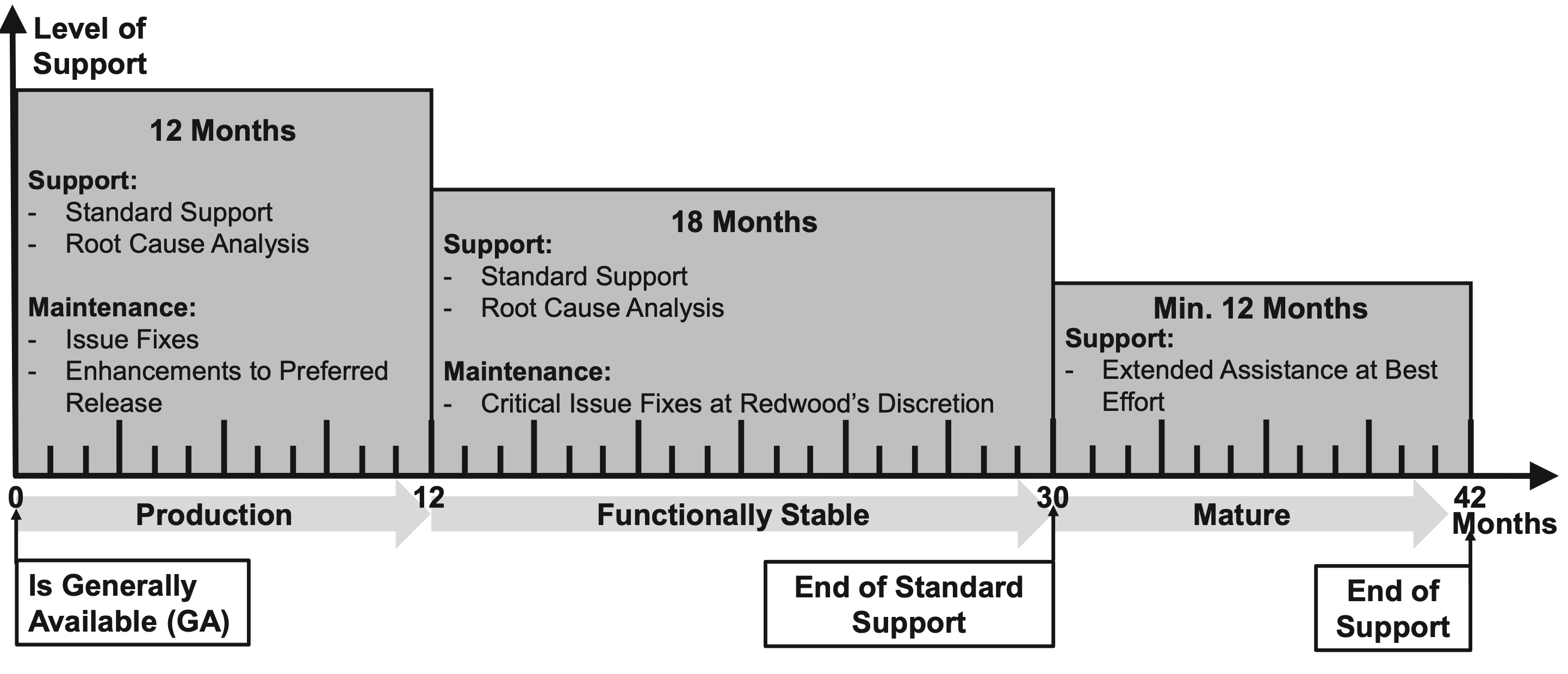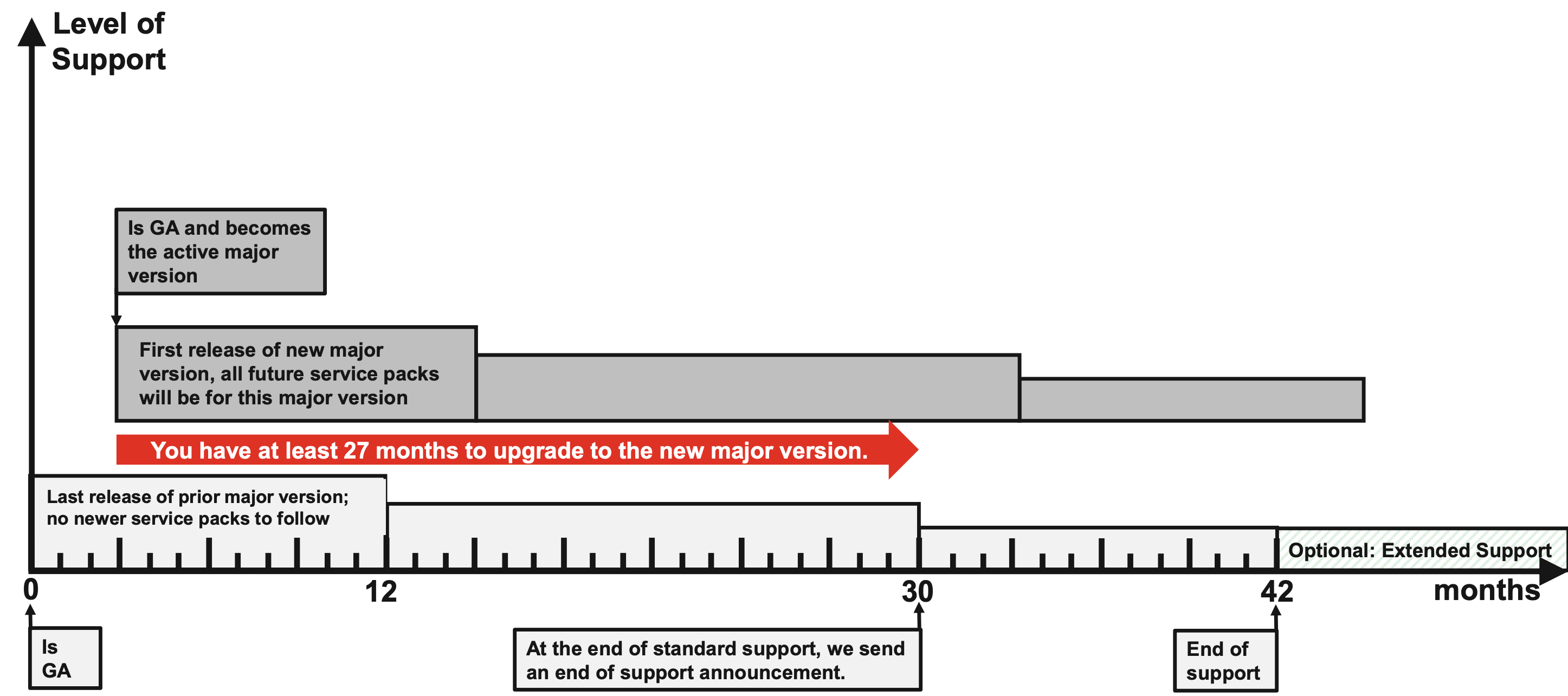 Product Release and Support Strategy for On-Site
Product Release and Support Strategy for On-Site
The Release strategy for on-site solutions ensures continues support.
Redwood development works in agile continuous delivery mode.
- Each available product has at least one active major version. Our development team only provides enhancements and updates to the active major version(s).
- Redwood provides regular service packs every three (3) months for active major versions.
- Redwood supports each service pack for 30 months. All fixes are made available within the first year. Redwood only adds product enhancements to the latest product version.
- You adjust the frequency of updates without losing support.
- Redwood recommends that you deploy a service pack update at least once a year.
Version Numbering
A version numbering is as follows <major_version>.<minor_version>.<service_pack>.<patch_level>. For update schedules, only the <major_version>.<minor_version>.<service_pack> part is relevant.
| Major Version/Upgrade | Minor Version/Update | Service Pack/Update | Patch Level/Patch | |
|---|---|---|---|---|
| Description | A new major version includes significant new functionalities and corrections. Redwood plans new major versions according to product roadmaps. | A new minor version is technically the same as a service pack. Redwood introduces a new minor version number when some prerequisites of the product have changed (e.g. It requires a newer version of Java). | A new service pack may include both product enhancements and fixes. Redwood provides service packs for active major versions on a quarterly basis. more details | A patch includes only corrections to reported issues. Patches are made available for all service packs in the production phase as required. They don’t follow a regular schedule. more details |
| Example Version change | Upgrade From: 2.0.4.13 To: 3.0.0.0 | Update 9.1.0.4 To: 9.2.0.0 | Update 9.2.8.4 To: 9.2.9.0 | Update 9.2.9.0 To: 9.2.9.4 |
Active Major Version and Service Packs
- Each available product has at least one active major and minor version. Our development team provides enhancements and fixes to both the major and minor versions.
- For active major versions Redwood provides service packs (SP) every 3 months.
- With an SP, only the third digit of the version changes (e.g. from 9.0.1 to 9.0.2). For more significant changes, Redwood makes a minor version change, adding to the second digit in the series (e.g. from 9.0.1 to 9.1.0. For major, new versions Redwood changes the first number in the series (e.g. 9.0.1 to 10.0.0).
- Redwood provides standard support for every SP for 30 months. After that, Redwood provides support at best effort.
- Redwood adds enhancements only to the most recent SP, which is the preferred release.
- SPs and patches are cumulative, so that the newest SP or patch includes all changes of the previous SPs and patches.
- Redwood recommends to update to the latest SP at least once a year.

Lifecycle Phases and Level of Support for EACH Product Version / Service Pack

New Major Versions
- When a significant amount of new functionality has been developed, Redwood launches a new major version.
- The new major version is shipped instead of a SP for the prior major version following the quarterly schedule.
- The new major version becomes the active one. This means that Redwood now only provides regular SPs to this new major version.
- The last SP of the prior major version will follow its normal lifecycle.
- You have 27 months to upgrade to the new major version without losing standard support.
- You also have the option to purchase extended support at best effort for the prior major version, after end of scheduled support.
For more details on this topic, please contact Redwood Support.

How to Install New Product Versions
You download all products and GA (General Availability) versions directly from the support portal. In every product version, Redwood ships software as a whole to ensure that you can install new product versions with minimal risk and effort. Newer patch levels and/or service packs include all previous changes. This means that it only takes one update to get the latest SP version. The process of installing a new version is designed to be simple and have no impact on the objects stored in the underlying database.
When you install a new version, the installation process itself manages all product components and connected agents on remote systems. This ensures compatibility and rapid deployment, further reducing risk and required effort.
Updates vs. Upgrades
Updates and upgrades use the same technical method, however, upgrading to a new major release often has a bigger impact than an update. A product update is usually fully automated. An upgrade may involve additional manual activities.
Redwood teams will suggest moving to a new major release when either:
- The product version used has reached end-of-life and is no longer supported.
- The release used by you no longer receives non-critical patches because it is deemed mature.
- Key requirements can only be met with the new major release.
See Also
onsiteTopic
